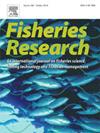Hunt for the Easter Sharks: A genetic analysis of shark and ray meat markets in Guatemala
IF 2.2
2区 农林科学
Q2 FISHERIES
引用次数: 0
Abstract
Guatemala, situated in Central America along the eastern Pacific Ocean and the western Caribbean Sea, is a major regional consumer of elasmobranch (shark and ray) meat during the Roman Catholic Lenten season. Elasmobranch meat is supplied by a combination of domestic fisheries and imports. Despite being a component of economic and nutritional security for local communities, fisheries and trade lack monitoring and management. Limited information on species-specific landings and fisheries and trade supply chains is further complicated by Guatemala’s bicoastal geography, which necessitates the separation of landings by geographic origin for robust stock assessments and targeted management interventions. This study employs molecular techniques to identify the species and, for the main species in trade, ocean basin provenance, occurring in meat samples collected from domestic markets across Guatemala in 2022 as well as historical samples from 2016 and 2017. Successful genetic testing of 370 meat samples identified 19 shark and ray species in the trade, including many threatened species, as well as a significant proportion of species now listed under the Convention on International Trade in Endangered Species of Wild Fauna and Flora (CITES). It also revealed substantial (22 %) mislabelling of teleost fish as elasmobranchs. Pacific coast markets and the largest inland market (Guatemala City, the largest urban centre) predominantly relied on domestic and imported landings from the Pacific coast, while Guatemala City also had inputs from domestic and likely imported landings from the Atlantic coast. One Atlantic coastal market sampled was exclusively supplied from that basin. Some imports of Pacific Ocean species are reported to CITES but there is limited national management of pelagic and coastal shark and rays landings on the Pacific coast, which needs to be rectified given the importance of these species and populations to elasmobranch meat consumption in Guatemala. Better enforcement of CITES is required to ensure sustainable imports of Atlantic Ocean sharks, while recent efforts to manage Atlantic domestic landings needs to be continued and likely expanded to promote sustainability.
猎杀复活节鲨鱼:危地马拉鲨鱼和鳐鱼肉市场的基因分析
危地马拉位于中美洲,沿着东太平洋和西加勒比海,是罗马天主教四旬斋季节期间鲨鱼和鳐鱼肉的主要区域消费者。蓝鳍鱼的肉由国内渔业和进口相结合的方式供应。尽管渔业和贸易是当地社区经济和营养安全的一个组成部分,但缺乏监测和管理。关于特定物种登陆以及渔业和贸易供应链的有限信息因危地马拉的双海岸地理而进一步复杂化,这就需要按地理来源将登陆区分开,以便进行强有力的种群评估和有针对性的管理干预。本研究采用分子技术来确定物种,对于贸易中的主要物种,在2022年从危地马拉国内市场收集的肉类样本以及2016年和2017年的历史样本中发现了海洋盆地来源。对370份肉类样本的成功基因测试确定了19种鲨鱼和鳐鱼,其中包括许多受威胁的物种,以及目前被列入《濒危野生动植物种国际贸易公约》(CITES)的很大一部分物种。它还揭示了大量(22% %)将硬骨鱼错误地标记为板鳃鱼。太平洋海岸市场和最大的内陆市场(危地马拉城,最大的城市中心)主要依靠来自太平洋海岸的国内和进口登陆,而危地马拉城也有来自大西洋海岸的国内和可能进口登陆的投入。抽样调查的一个大西洋沿岸市场完全由该盆地供应。向CITES报告了一些太平洋物种的进口情况,但对太平洋沿岸的远洋和沿海鲨鱼和鳐鱼的国家管理有限,鉴于这些物种和种群对危地马拉的elasmobranch肉类消费的重要性,需要纠正这种情况。需要更好地执行CITES,以确保大西洋鲨鱼的可持续进口,而最近管理大西洋国内捕捞的努力需要继续,并可能扩大,以促进可持续性。
本文章由计算机程序翻译,如有差异,请以英文原文为准。
求助全文
约1分钟内获得全文
求助全文
来源期刊

Fisheries Research
农林科学-渔业
CiteScore
4.50
自引率
16.70%
发文量
294
审稿时长
15 weeks
期刊介绍:
This journal provides an international forum for the publication of papers in the areas of fisheries science, fishing technology, fisheries management and relevant socio-economics. The scope covers fisheries in salt, brackish and freshwater systems, and all aspects of associated ecology, environmental aspects of fisheries, and economics. Both theoretical and practical papers are acceptable, including laboratory and field experimental studies relevant to fisheries. Papers on the conservation of exploitable living resources are welcome. Review and Viewpoint articles are also published. As the specified areas inevitably impinge on and interrelate with each other, the approach of the journal is multidisciplinary, and authors are encouraged to emphasise the relevance of their own work to that of other disciplines. The journal is intended for fisheries scientists, biological oceanographers, gear technologists, economists, managers, administrators, policy makers and legislators.
 求助内容:
求助内容: 应助结果提醒方式:
应助结果提醒方式:


